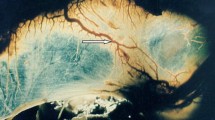Abstract
Background
Only limited attention has been paid to the anatomy and clinical importance of the falcine venous plexus. The aim of this study was to evaluate the falcine venous plexus anatomically using scanning electron microscopy (SEM), and to provide guidance for neurosurgical approaches.
Methods
Latex or ink was injected into the superior and inferior sagittal sinus. The falcine venous plexus lying within the connective tissue of the falx cerebri was observed by dividing the falx into thirds (anterior, middle and posterior). Further, the SEM appearance of the falcine venous plexus was evaluated.
Results
The anterior third of the falx cerebri consisted of small diameter falcine venous vessels. These vessels were localized close to either the superior or inferior sagittal sinus, and none extended as far as mid-falx cerebri levels in any of the 16 cases. They communicated with either superior or inferior sagittal sinuses, but not with both of these sinuses. In the middle third of the falx cerebri, the majority of the vessels of the falcine venous plexus had larger diameter compared to those of the anterior third. These vessels extended the length of the falx cerebri levels. They communicated with both superior and inferior sagittal sinuses. In the posterior third of the falx cerebri, the vessels of the falcine venous plexuses had the largest diameter and were located at the junction of the inferior sagittal sinus and the straight sinus. They were localized at the lower two-thirds of the falx cerebri. In all cases, the dense venous networks communicated with the inferior sagittal sinus but not with the superior sagittal sinus. The falcine venous plexus observed in the posterior third of the falx cerebri was denser than in the anterior and middle portions.
The SEM revealed small vessels whose diameter ranged between 42 and 138 μm. The vessels of the falcine venous plexus in the anterior third had a mean diameter of 0.42 ± 0.1 mm, in the middle third a mean diameter of 0.87 ± 0.17 mm, and in the posterior third, 1.38 ± 0.21 mm.
Conclusion
The falcine venous plexus is a network of venous channels that exists within the connective tissue of the falx; the sizes and patterns of communication of these structures showed regional differences. Neurosurgeons should be aware of the regional differences when making an incision or puncturing the falx during a surgical approach.







Similar content being viewed by others
References
Afifi AK BR (1998) Functional Neuroanatomy. McGraw-Hill, pp 62
Babu R, Barton A, Kasoff SS (1995) Resection of olfactory groove meningiomas: technical note revisited. Surg Neurol 44:567–572
Brown RW (2009) Histologic preparations: common problems and their solutions. College of American Pathologists, pp 56–57
Cai CQ, Zhang QJ, Yang WD, Wang CX, Shen CH (2009) Neuroimages of persistent falcine sinus in children. World J Pediatr 5:63–64
EL Cushing H (1939) Meningiomas. Their classification, regional behaviour, life history, and surgical end results. Br J Surg 26:957–957
Elsherbiny SM, Grunewald RA, Powell T (1997) Isolated inferior sagittal sinus thrombosis: a case report. Neuroradiology 39:411–413
Giombini S, Solero CL, Lasio G, Morello G (1984) Immediate and late outcome of operations for parasagittal and falx meningiomas. Report of 342 cases. Surg Neurol 21:427–435
Grunewald R, Powell T, Elsherbiny S (1998) Inferior sagittal sinus thrombosis. Neuroradiology 40:472
Hamilton WJMH (1972) Human embryology, 4th edn. The Williams and Wilkins Company, Baltimore, p 453
Kashimura H, Arai H, Ogasawara K, Ogawa A (2007) Persistent falcine sinus associated with obstruction of the superior sagittal sinus caused by meningioma–case report. Neurol Med Chir 47:83–84
Katelaris A, Kencian J, Duflou J, Hilton J (1994) Brains at necropsy: to fix or not to fix? J Clin Pathol 47:718–720
Keogh AJ, Sharma RR, Vanner GK (1993) The anterior interhemispheric trephine approach to anterior midline aneurysms: results of treatment in 72 consecutive patients. Br J Neurosurg 7:5–12
Kesava PP (1996) Recanalization of the falcine sinus after venous sinus thrombosis. Am J Neuroradiol 17:1646–1648
Kim MS, Lee GJ (2010) Two Cases with Persistent Falcine Sinus as Congenital Variation. Journal of Korean Neurosurgical Society 48:82
Lacerte D, Gagne F, Copty M (1996) Intracranial chondroma. Report of two cases and review of the literature. Can J Neurol Sci 23:132–137
Manoj KS, Krishnamoorthy T, Thomas B, Kapilamoorthy TR (2006) An incidental persistent falcine sinus with dominant straight sinus and hypoplastic distal superior sagittal sinus. Pediatr Radiol 36:65–67
Martin JH (1996) Neuroanatomy, 2nd edn. McGraw-Hill, pp 19–111
Netter FH (1983) Nervous system. Ciba-Geigy Cooperation, pp 56
Nikas DCBL, Black PM (2000) Parasagittal and falx meningiomas. In: Kaye AHBP (ed) Operative Neurosurgery. Hartcourt Publishers Ltd, London, pp 505–521
Olivecrona H (1947) The parasagittal meningiomas. J Neurosurg 4:327–341
Protasoni M, Sangiorgi S, Cividini A, Culuvaris GT, Tomei G, Dell’Orbo C, Raspanti M, Balbi S, Reguzzoni M (2011) The collagenic architecture of human dura mater. J Neurosurg 114:1723–1730
Rhoton AL Jr (2002) The cerebral veins. Neurosurgery 51:S159–205
Ryu CW (2010) Persistent falcine sinus: is it really rare? Am J Neuroradiol 31:367–369
Sheerin F (2009) The imaging of the cerebral venous sinuses. Seminars in Ultrasound, CT, and MR 30:525–558
Strub WM, Leach JL, Tomsick TA (2005) Persistent falcine sinus in an adult: demonstration by MR venography. Am J Neuroradiol 26:750–751
Toledo MM, Wilson TJ, Dashti S, McDougall CG, Spetzler RF (2010) Dural arteriovenous fistula associated with superior sagittal sinus occlusion secondary to invasion by a parafalcine meningioma: case report. Neurosurgery 67:205–207, discussion 207
Tubbs RS, Loukas M, Louis RG Jr, Shoja MM, Acakpo-Satchivi L, Blount JP, Salter EG, Oakes WJ, Wellons JC 3rd (2007) Anatomy of the falcine venous plexus. J Neurosurg 107:155–157
Williams PL, Warwick R, Dyson M, Banister LH (1989) Gray’s anatomy, 37th edn. Churchill Livingstone, London, pp 1086
Acknowledgments
The authors thank Dr. Uğur Ünal from Koç University for his technical support with scanning electron microscopy.
Conflicts of interest
None.
Author information
Authors and Affiliations
Corresponding author
Additional information
Comment
The study by Tatarlı and Colleagues describing the macroscopic and microscopic anatomy of the venous system forming a "falcine venous plexus" is particularly relevant to neurosurgical practice. Actually, this falcine venous plexus could play an important role as a collateral venous outflow pathway when the superior sagittal sinus is occluded by a parasagittal meningioma.
When dealing with meningiomas occluding the middle or posterior third of the superior sagittal sinus, resection of the sinus en bloc with the tumor is commonly considered a safe procedure. Nevertheless, several cases of patients who deteriorated and died following en bloc resection of a completely occluded sinus with the tumor have been described. This circumstance could be reasonably explained on the grounds of lack of development of adequate collateralization of the venous outflow anterior to the site of occlusion. The implication is that in those cases without adequate collateralization of the venous outflow anterior to the site of occlusion, a complete en bloc resection of the tumor with the sinus could interrupt anastomotic pathways that run through the tumor, the capsule of the tumor, or even the walls of the sinus and along the falx [1]. The present study clearly demonstrates the existence of a venous plexus coursing along the falx that otherwise could be only supposed.
The resection of a parasagittal meningioma together with the occluded sinus should be therefore performed only if there is evidence that an adequate venous outflow from the sinus anterior to the area of occlusion has been developed. This can occur by drainage through the most distal patent veins prior to the occlusion into alternative routes like the transverse sinus through the vein of Labbé or the spheno-parietal sinus through sylvian veins [2].
References
1. Heros RC (2006) Meningiomas involving the sinus. J Neurosurg 105:511-513; discussion 513
2. Tomasello F, Conti A, Cardali S, Angileri FF (2013) Venous preservation-guided resection: a changing paradigm in parasagittal meningioma surgery. J Neurosurg 119(1):74-81
Alfredo Conti
Francesco Tomasello
Messina, Italy
Rights and permissions
About this article
Cite this article
Tatarlı, N., Ceylan, D., Canaz, H. et al. Falcine venous plexus within the falx cerebri: anatomical and scanning electron microscopic findings and clinical significance. Acta Neurochir 155, 2183–2189 (2013). https://doi.org/10.1007/s00701-013-1863-1
Received:
Accepted:
Published:
Issue Date:
DOI: https://doi.org/10.1007/s00701-013-1863-1




